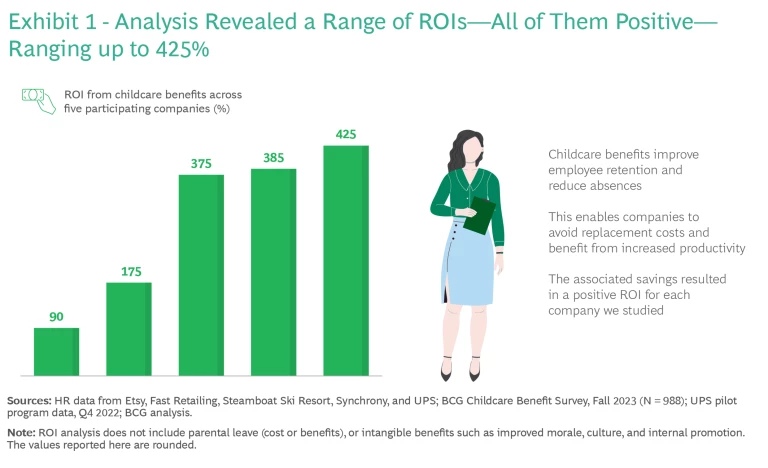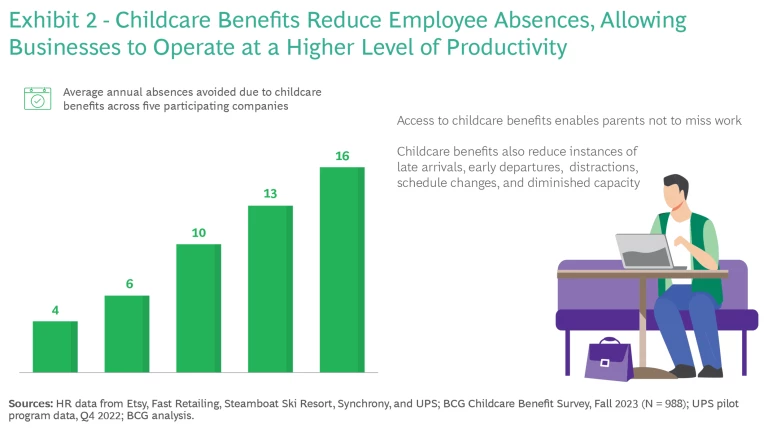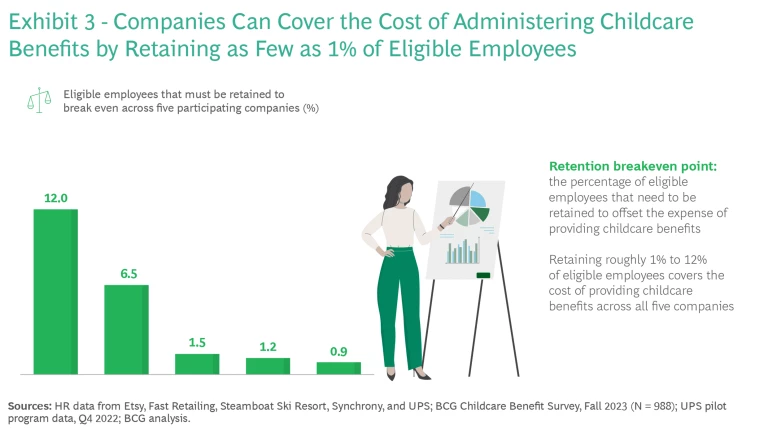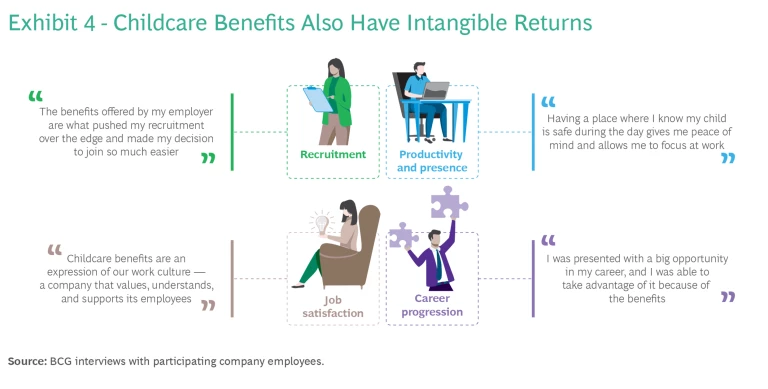Steamboat Ski Resort, situated deep in the Rocky Mountains, is an ambitious organization with 750 year-round employees and another 1,200 seasonal workers. But when the COVID-19 pandemic shuttered critical childcare options in its hometown of Steamboat Springs, Colorado, the company’s ability to attract and keep great people was put to the test. That’s when Morgan Bast and Loryn Duke, who lead the company’s marketing and communications departments, combined their resources to create a new childcare facility for Steamboat families—a bright onsite space for kids from eight weeks to seven years old that includes licensed caregivers and preschool teachers, indoor and outdoor play, and easy and flexible drop-off and pickup.
Today, with startup costs funded equally by the resort and the State of Colorado, the Steamboat Child Care Center is bustling with 35 children and managing a waiting list. And Steamboat Ski Resort, a unit of Alterra Mountain Company, is way ahead. Its working parents, who pay a subsidized rate for the service, say that they might have quit their jobs without it, and they are more focused and effective because they’re free of extra worry in a region that qualifies as a “childcare desert.” The company is forging deeper relationships with the town by offering some childcare spots to nonaffiliated families, and in 2023 it won a Governor’s Citizenship Medal for the program.
Childcare Benefits Are a Smart Investment
US companies that have added childcare benefits to their employment packages are seeing quick and lasting rewards in recruiting, retention, and productivity, according to a study we conducted in fall 2023. In fact, we found that offering childcare benefits can pay off so quickly that it should be a no-brainer for employers in a competitive hiring landscape to do so.
Our study examined the value and consequences of providing help with childcare to working parents at five companies—Etsy, Fast Retailing, Steamboat Ski Resort, Synchrony, and UPS. These companies vary in size and employee mix, and represent five different industries—e-commerce, retail, hospitality, financial services, and supply chain management. The research, which we carried out in collaboration with Moms First, a nonprofit organization that focuses on advancing equality for women in the workplace, encompassed financial analysis, survey responses from approximately 1,000 employees, and personal interviews.

The results debunk a widespread perception that employer-sponsored childcare benefits are strictly a cost center. Instead, we found that all five companies obtained a positive return on investment (ROI)—from 90% to as high as 425%. (See Exhibit 1.) They reported ROI gains whether the childcare benefits went to salaried or hourly workers.
Corporate leaders who have considered this kind of expense but haven’t drilled down to identify the potential positive returns could reimagine childcare benefits as an investment that merits serious consideration. Research by Care.com has shown that such benefits attract and retain working parents at least as much as health care and retirement benefits.
Parents miss far less work when they can count on reliable, available childcare. Those surveyed said that they avoided up to 13 work absences a year when they no longer had to juggle childcare disruptions. (See Exhibit 2.) Their responses are consistent with data from a pilot program at UPS, which added onsite emergency childcare in one Northern California facility from October to December 2022. UPS reported that it avoided an average of three employee absences a day during that brief period. The company, which processes 5 billion packages a year and employs nearly 500,000 people, is expanding its childcare experiment to eight sites in six states by the end of 2024.

Given the high cost of recruiting and training new workers, every company in our study recouped the full annual expense of its childcare benefits by preventing just a few departures. We calculated that retention breakeven point—the number of employees that the company needs to retain annually to cover the cost of providing childcare benefits—as the total cost of providing the benefits divided by the average expense of replacing an eligible employee. The figure ranged from just under 1% to 12% of the total number of eligible employees for each company. (See Exhibit 3.)

“This was truly uncharted territory, but we created a solution that makes a difference in the lives our of frontline employees,” said Nando Cesarone, executive vice president and president of domestic operations at UPS. “This program offers a true childcare backup option, giving parents the flexibility they need, particularly when life has its unexpected turns.”
At Etsy, the Brooklyn, New York–based e-commerce company with $2.7 billion in revenue last year, employees may qualify for up to $4,000 a year in childcare credits, which they can spend with a contracted provider that offers onsite or at-home care options, or on their own private care plan. Of the eligible Etsy working parents we surveyed, 82% said that childcare benefits were an important factor in selecting their employer. Maureen Sitterson, who recently received a promotion to senior director of global product marketing, has two kids—and she plans to stick with Etsy. “Even if another company offered me more money tomorrow, I wouldn’t even consider it,” she said.
The lack of affordable, high-quality childcare for 50 million working parents is an overwhelming problem in the US economy. More than half of Americans live in a census tract with three times as many children who might need day care as there are slots with licensed caregivers. This is the “childcare desert” scenario. Meanwhile, good care is expensive, especially for infants. Research by Care.com indicates that 60% of US households pay more than 20% of their annual income for childcare. Among parents leaving the workforce, 26% cited the high cost of childcare as a primary reason, according to a 2022 survey by the US Chamber of Commerce.
Just 12% of all US workers have access to childcare benefits through their employer, a figure that drops to 6% for people who work part-time or in the lowest income quartile. “Deskless workers,” who occupy 70% of US jobs, have the greatest need for help with childcare and, often, the most at stake when their arrangements fall apart. Still, more than 75% of companies don’t design their benefits to meet the needs of deskless workers. This may represent a missed opportunity for corporate leaders coping with substantial turnover in those kinds of jobs.
Our study covered an array of childcare benefit strategies, including onsite or near-site facilities for regular use, backup services such as on-demand or drop-in care, and stipends to help parents pay for their own arrangements. In all scenarios, returns were positive. Some programs involve government support in the form of funding, coordination, or policy change. That is consistent with the perspective that longer-term, systemic childcare solutions will require commitments from both the private and public sectors.
Our study did not factor in separate family leave policies that support new parents and babies, such as paid time off to recover from childbirth and hybrid work arrangements to help employees coordinate work and family responsibilities.
The Financial and Cultural Advantages of Childcare Benefits
Our research indicates that companies that take direct action to help employees with childcare may gain a competitive advantage. For each company in our study, we calculated the percentage ROI from the company’s childcare program as the net financial impact from retention savings and improved productivity versus the net cost to administer the program. ROI, for our purposes here, is a yearly cost-avoided metric. Companies don’t receive these investment returns directly; rather, they achieve them by avoiding costs that they would otherwise incur.

Some important intangible advantages of corporate childcare benefits are harder to quantify, yet survey participants widely discussed them. (See Exhibit 4.) In numerous interviews, employees described these benefits as a billboard of positive corporate culture—something that they could point to and say “I know my company cares about me.” Up to 86% of respondents said that they were more likely to stick with their employer because of its childcare benefit. As many as 78% said that the resulting peace of mind had given their careers a boost. They appreciated having coworkers and managers who understood their family needs, and they felt more ambitious, productive, and open to accepting tougher assignments.
That’s true of Suleyka Basil, a store manager in New York City at Uniqlo, a clothing retailer with about 4,800 US employees that’s a unit of Japan-based Fast Retailing. When she learned that she was pregnant with twins, Basil prepared to quit her job to take care of the babies because she didn’t think she could afford childcare. But then the company announced a new childcare stipend of up to $1,000 a month for 36 months for management-track employees. “It truly saved us,” said Basil, who feels more committed to her job than ever. Fast Retailing childcare benefits pay for themselves by averting just 15 departures among eligible employees each year.
At Synchrony, Gleydis Gonzalez, a former teacher, takes advantage of up to 60 days a year of backup care reimbursements for her three children, now ages 3, 7, and 9. She joined the Stamford, Connecticut, company, where her husband is also employed, three years ago and works as a recovery specialist. She’s so satisfied with Synchrony that she has since recruited two other working parents from her immediate network to join the company. About 24% of its US employees have children under the age of 12.
“Our childcare benefits are making Synchrony a leading employer of choice while strengthening our workforce,” said Carol Juel, the company’s chief technology officer and chief operating officer.
This report is the fourth in a BCG series on the US care economy, a vast ecosystem valued at almost $6 trillion of economic activity a year, including unpaid work. In December 2022, we forecasted that the US will lose about $290 billion in GDP a year by 2030 by failing to confront an evolving crisis in care that has two key components: too few care workers, and too many productive people leaving their jobs—whether they want to or not—to handle care obligations in an inefficient and disorganized marketplace.
Many US companies so far have refrained from offering childcare benefits, even as they have grown and innovated in their other human resources offerings.
Our research over the past two years demonstrates that society as a whole is diminished when it fails to recognize that high-quality, affordable care—including childcare, elder care, and care for the sick—are integral to the smooth functioning of the whole economy. Many women and an increasing number of men must cut back on paid work or leave the workforce altogether to handle their care responsibilities. The integrity of the workforce rides on the strength of the care economy.
The corporate sector has a significant role to play in enabling parents to remain in the workforce. This latest research offers evidence that providing childcare benefits make sense both financially and strategically. Childcare benefits pay for themselves in myriad ways—most notably by preventing employee absences and departures year after year. The rest is upside.
The authors thank their BCG colleagues Monica Campos and James Hinckley for their contributions to the research and analysis in this article. They thank Lisa Kassenaar for her writing assistance. They also thank Joe Fuller, Misty Heggeness, and Emily Oster for reviewing and advising on the methodology.






